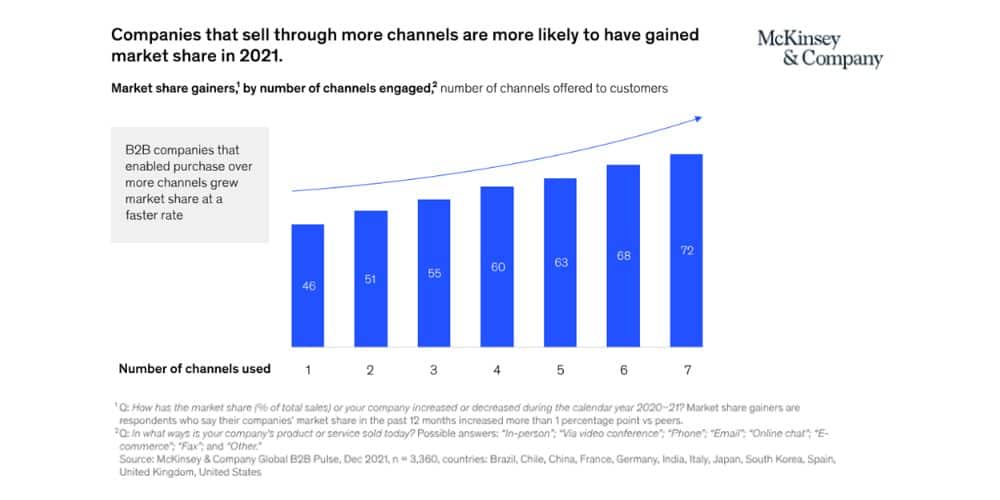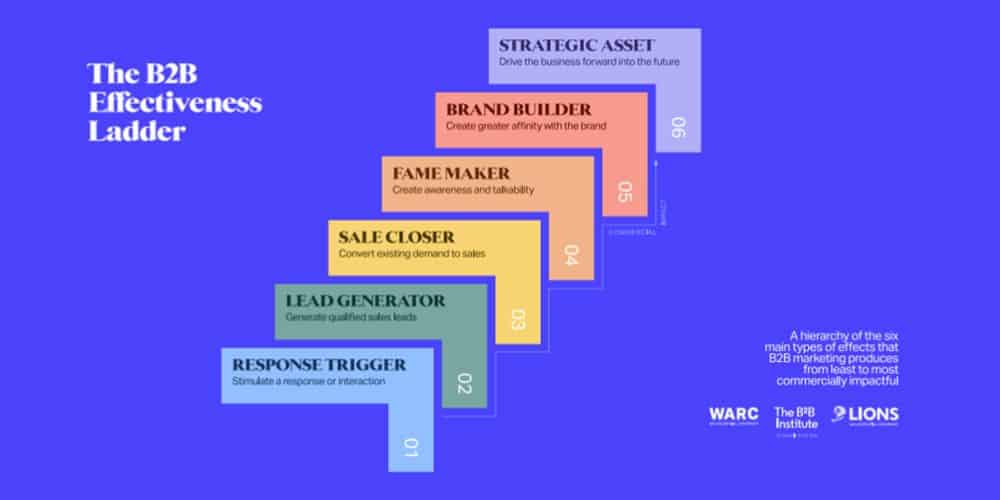
Recently, LinkedIn think tank, The B2B Institute, released a 50-page B2B Marketing Research report on marketing effectiveness. The findings, insights and advice were all collected over the course of a decade (2010-2021).
Let’s break down the key findings and align them with what we, at Cremarc, know from our client work in that time.
The long AND the short
The classic work by Peter Field and Les Binet, The Long and the Short of it (2013), became the go-to marketing guide and the insights and direction within it are still relevant almost ten years later.
Research shows that B2B brands grow and succeed when they have a balance of long-term brand building activity and short-term sales activation campaigning. The ideal ratio of this balance it deemed to be 60:40 in favour of brand building.
With a greater focus on the wider serviceable market and not just on the individuals ready to buy today, brand building allows brands to make a bigger impact on individuals. After all, if I were to ask you whether you wanted a fancy soft drink, you’d likely think of Coca-Cola. You haven’t been served a Coca-Cola ad while reading this blog post. That is the effect of long-term brand building – it’s just as, if not more powerful than short-termism.
Part of our job as a marketing agency is to educate our clients on the best direction for their marketing. Usually, this comes in the form of the original brief saying that the focus is on form fills. The reality? Form fills don’t happen overnight. Start building a brand and as people become ‘in the market’ they’ll naturally reach out to you.
Get the balance of short-term and long-term right, and you are more likely to succeed.
Spread your activity across more media
Generally, in B2B marketing, Creative Commitment was seen to be falling. Creative Commitment is a piece of analysis which shows that campaigns become more effective as they receive greater media spend, run for longer durations, and are also spread out across a more diverse range of media channels.
Essentially, the longer your campaign runs for and the more media channels it is displayed on, backed by more budget, the better return you’ll get. This isn’t anything new – it’s obvious that the ‘bigger’ a campaign is, the more results it’ll receive – but it seems to be forgotten in B2B marketing. We’ve seen companies run a new campaign every month. Put simply, this doesn’t work. The most successful campaigns we’ve run as an agency have lasted at least 3 months – sometimes up to a year!
Interestingly, this insight was also found to be the same for B2C marketing campaigns. Only the difference is that B2C campaigns are often run for the long-term while B2B campaigns focus on the short-term with an instant sales activation mindset. If this is the mindset you take with your advertising, you don’t grow. It’s that simple. Run campaigns for longer and run them in more places.
Reach is the top of the funnel metric that often gets overlooked. If you work top-down and push for the highest possible number at the top of your funnel, you’ll be more likely to have hand raisers fall to the bottom. You’ll also get more of an opportunity to drive individuals and accounts down through the funnel.
Reach on one channel is great, but reach across multiple channels helps to acquire individuals that are located in different areas. Alongside this, comes improvements to your chances of cross-platform exposure to one individual – extending the mental availability you’ve already unlocked.
Furthermore, in today’s business world of larger buying committees, you need to be ‘known’ by more people to help streamline that procurement and purchasing cycle. Pushing for wider reach across multiple channels helps to encompass as many category buyers and decision makers as possible.
According to research, the B2B marketing community is reducing spend, duration and number of media channels used for their campaigns. This is the total opposite of what should be occurring!
The below graph explains the relationship between the number of channels utilised and campaign effectiveness.

(Photo: Graph showing the correlation between number of channels engaged and number of channels used, courtesy of McKinsey & Company)
The B2B Effectiveness Ladder
The B2B Effectiveness Ladder (B2BEL) was designed to continually support B2B marketers in commercially improving their campaigns. The B2BEL is a hierarchy of the six main types of effects that B2B marketing produces, in order of commercial efficacy.

(Photo: A visual representation of the B2B Effectiveness Ladder)
The B2B Institute analysed the strategy and creative work of the 100 most effective B2B campaigns (between 2010 -2021), revealing the commonalities among the campaigns, looking more specifically at those which disproportionally achieved impressively at each level.
With this ladder, we can get an indication of the types of strategic and creative choices that are ‘winning behaviours’ and use these to construct successful campaigns of our own. We are already using this ladder at Cremarc, and you should be too!
Each rung of the ladder has its own winning behaviours. Below, we outline these:
RESPONSE TRIGGER
‘Don’t be a boring business’ – make the campaign exciting so it breaks through the noise and makes a bigger impact.
‘Demonstrate product benefits in surprising ways’ – instead of bullet pointing the benefits of your product, solution or service, show what it does in a more interesting way.
‘Catch people off-guard’ – linking with the first point, you have to make an impact. Having the shock factor is a great way to achieve a scroll-stopping result.
LEAD GENERATOR
‘Target insightfully’ – successful lead generators use insightful targeting by both showing up in the right place and by delivering the right kind of content.
‘Get playful with your direct marketing’ – highly creative direct marketing gets the target individual involved, makes them think, and hooks them into the key message. Again, it’s about making that impact and drawing the consumer in.
‘Be useful’ – deliver something of value. The best marketing gets someone onside rather than instantly trying to sell to them.
SALE CLOSER
‘Activate the channel’ – incentivise and support partners and resellers of your product or service.
‘Lead thought’ – thought leadership activity positions you as a market leader, an expert in the field, and proactively supportive in adding value to the target business.
‘Prove your ongoing relevance’ – this is just a less detestable way of saying “be disruptive”.
FAME MAKER
‘Be surprising and original’ – push boundaries and be unique to make an impact and grab attention.
‘Champion a purpose or cause’ – fight for something and the followers of that thing will also follow you too. Use the market of agree-ers to elevate your brand and to advocate for your mission.
‘Do something everyone can be a part of’ – make it easy for people to follow you. This will play into your favour when a buying committee is discussing your solution. If more of the procurement committee know who you are and already trust you, the hard part is done.
BRAND BUILDER
‘Use emotion’ – emotion is one of the best ways to be memorable, and mental availability is at the core of marketing.
‘Target broad audiences’ – just as Byron Sharp’s legendary How Brands Grow states, to grow you must target the full category, not just the obvious segment.
‘Address key brand weaknesses’ – pick just a handful of key metrics and focus on improving them. Don’t try and boost every metric.
Conclusion
If we look at the most successful campaigns over the past decade, we can see that to drive marketing effectiveness and business growth, you need a combination of things. Don’t try and do it all at once. Do everything, everywhere all at once, separately. Target the full category and segment insightfully, but not at the same time.
Communicate directly with individuals but also work with partners to improve reach and outsource growth opportunities. Be familiar and expected but also unique and new. Show knowledge and experience but also innovation and change. Most importantly, use emotion and creativity. You need to make an impact and unlock a reaction to boost mental availability.
Thanks to the B2B Institute for this incredibly insightful research around marketing effectiveness. This gives all us marketers something to aim for. If you need a hand with your direction and strategy, please get in touch. We’d love to help.
If you wanted to read more about the discussion points in this article, you can download the full B2B marketing research report.